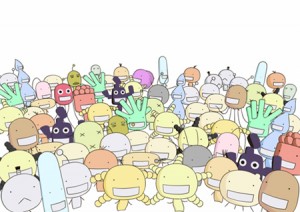In the first part of this post, I introduced the notion of a visual alien, an isolated unit which is drawn in a markedly different visual style from its surrounding. I also postulated that there were two basic reasons to include a visual alien: Distinctness (to underline the alien’s difference from everything else) and Virtuosity (to show off). In this post I will be illustrating with some examples of visual aliens by a single artist, drawn from American comics. In principle, a visual alien could be anything — well, anything that can be drawn, anyway. It could be a cloud, a table, a rock, a tiger. But in the examples that follow I will focus on characters that are visual aliens (although I would love to hear of non-character examples).
A natural place to look for visual aliens is in parody and pastiche, and in particular visual parody/pastiche, where one artist imitates the visual style of another. But in most visual parodies or pastiches (or at least the ones I’m familiar with), the parodist simply imitates the entire style of the parodied artist, drawing everything in the parodied’s visual style. This is the case with (most of) Veitch and Sikoryak, discussed in the last post, but also with (for instance) Al Capp’s parody of Chester Gould’s Dick Tracy (“Fearless Fosdick”) or Elder’s parody of Archie (“Starchie”). Fearless Fosdick is confined to his own strip-within-a-strip, which is drawn in Gould’s style throughout; in Starchie, all the characters are drawn in the Archie house style — except for a brief cameo on the first page by Little Orphan Annie, who is drawn in Harold Gray’s style. Here, as a visual parody within another parody, we have Annie as a visual alien.



